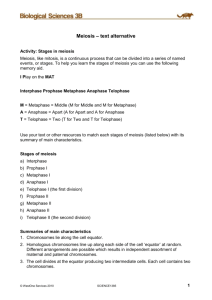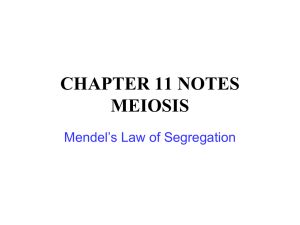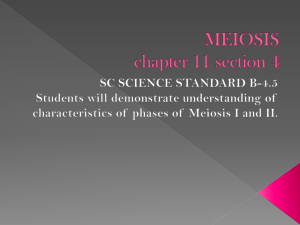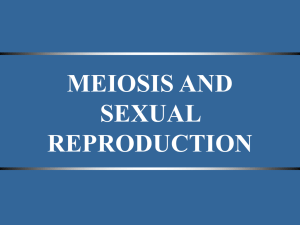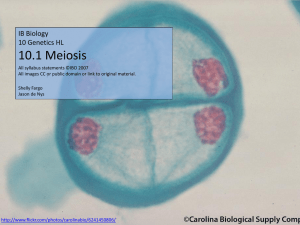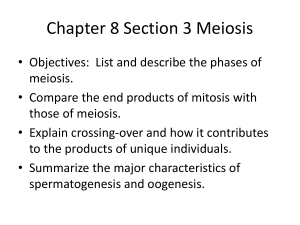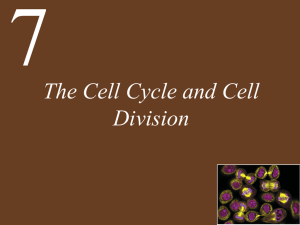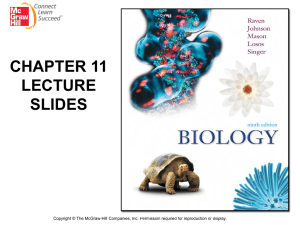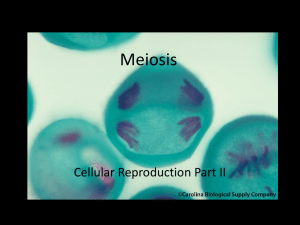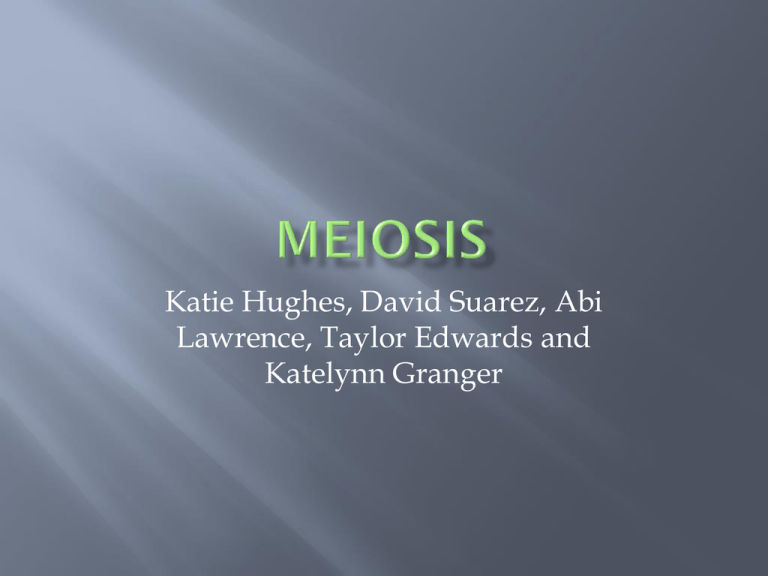
Katie Hughes, David Suarez, Abi
Lawrence, Taylor Edwards and
Katelynn Granger
4.2.1: State that meiosis is a reduction division of
a diploid nucleus to form haploid nuclei.
Called reduction division because the daughter
cells have only half of the number of chromosomes
as the parent cell
Purpose: To produce gametes to facilitate sexual
reproduction
Result: Four haploid cells
OVERVIEW:
http://highered.mcgrawhill.com/sites/0072495855/student_view0/chapter28/ani
mation__stages_of_meiosis.html
Spilt into 2
parts:
Meiosis I
Prophase
Metaphase
Anaphase
Telophase
Meiosis II
Prophase
Metaphase
Anaphase
Telophase
Haploid-a cell having half the number of
chromosomes than a somatic cell
Somatic cell- normal body cell
gamete- sex cell (sperm or egg cell)
Chiasmata-the site at which crossing over takes
place. The process of crossing over
Interphase
Cell growth and DNA replication (review--before meiosis I)
Prophase I
Chromosomes condense
Homologous chromosomes pair up and crossing over occurs
(the point of cross over is known as the chiasmata)
Nuclear membrane disintegrates and the centrioles travel to the
poles of the cell
Metaphase I
Microtubules form a spindle and the spindle fibers
attach to the centromeres of the chromosomes
Pairs of homologous chromosomes align along the
metaphase plate
Anaphase I
Spindle fibers shorten and pull paired
chromosomes in opposite directions
Paired homologous chromosomes
separate and pulled to opposite poles
(sides) so that each pole contains one
chromosome of each pair.
Telophase I
A nuclear membrane forms around the
chromosomes at each pole and chromosomes uncoil
Spindle fibers disintegrate
The cell undergoes cytokinesis to form two daughter
cells (two haploid cells)
At the end of telophase I the cells may enter a short
interphase period or proceed directly to meiosis II
DNA is not replicated
Mostly the same!!! Except this time it involves half the number of
chromosomes as Meiosis I
Prophase II
Metaphase II
SAME
Anaphase II
No crossing over (chiasma)
Separation of sister chromatids, instead of homologous chromosomes
Telophase II
SAME
RESULT: FOUR HAPLOID DAUGHTER CELLS.
http://www.phschool.com/science/biology_place/biocoach/meiosis/mei2a
ni.html
http://ww
w.johnkyrk.
com/meiosi
s.html
10.1.2 Outline the formation of chiasmata in the
process of crossing over
New combinations of genes within
chromosomes are possible through this process
Can occur between any non-sister chromatids
During prophase I, chromatids are close
together, so parts of each chromatid overlap,
break at the chiasmata and reattach to the other
chromatid
Sister chromatids a, b, c and d (b and c end up
as new combinations called recombinants
10.1.3 Explain how meioisis results in an
effectively infinite genetic variety in gametes
through crossing over in prophase I and
random orientation in metaphase I
The number of chiasmata, or points of crossing
over, can differ…..infinite variety!!
10.1.4
States that any one of a pair of characteristics
may combine with either of another pair.
So, two characteristics must be on different
chromosomes
Since any combination of chromosomes is
possible in metaphase I, any one pair of
characteristics may combine with either of
another pair
Takes place within somatic
(body) cells
Results in 2 daughter cells
Mother cell can be haploid
of diploid
Is preceded by a S-phase
No homologous pairing of
chromosomes
Genotype of daughter cells
are identical to mother
cells
•Takes place within gametes
(sex cells)
•Results in 4 haploid gametes
•Mother cell is diploid
•Only meiosis I preceded by a
S phase
•During prophase I,
homologous chromosomes
pair up
•Meiotic products differ in
their genotype from the
mother cell
Works Cited
"Chromosomes Crossing Over." Sciencelearn. University of Waikato, 8 June 2011. Web. 14 Feb. 2012.
<http://www.sciencelearn.org.nz/Contexts/Uniquely-Me/Sci-Media/Images/Chromosomescrossing-over>.
Farabee, M.J. "CELL DIVISION: Meiosis..." Estrella Mountain Community College. 18 May 2010. Web. 10
Feb. 2012. <http://www.emc.maricopa.edu/faculty/farabee/biobk/biobookmeiosis.html>.
Griffiths, Anthony J. F. An Introduction to Genetic Analysis. New York: W.H. Freeman, 2000. Print.
Hill, McGraw. "Stages of Meiosis." Highered.mcgraw-hill.com. McGraw Hill. Web. 10 Feb. 2012.
<http://highered.mcgrawhill.com/olcweb/cgi/pluginpop.cgi?it=swf::535::535::/sites/dl/free/0072437316/120074/bio19.swf::Stages%20of
%20Meiosis>.
"IB Biology Notes - Meiosis." IB Guides - Free International Baccalaureate Study Guides, Notes, Videos and
Powerpoints. Web. 10 Feb. 2012. <http://www.ibguides.com/biology/notes/meiosis>.
Khara, Kanika. "Difference Between Mitosis and Meiosis." Buzzle Web Portal: Intelligent Life on the Web.
Buzzle. Web. 14 Feb. 2012. http://www.buzzle.com/articles/difference-between-mitosis-and-meiosis.html
.
Kyrk, John. "Meiosis = Double Cell Division." Communicating at an Unknown Rate. 2012. Web. 14 Feb. 2012.
<http://www.johnkyrk.com/meiosis.html>.
Peeters, Weem Minka., Christopher Talbot, and Anthony Mayrhofer. Biology. Melton: Ibid, 2007. Print.
"Phases of Meiosis | Biology." Khan Academy. Web. 10 Feb. 2012.
<http://www.khanacademy.org/video/phases-of-meiosis?topic=biology>.

